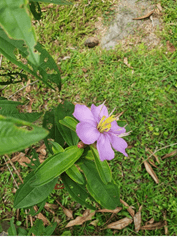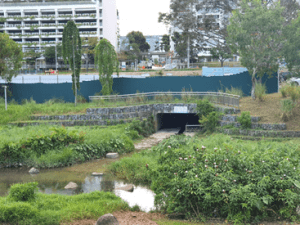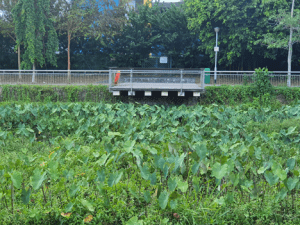Recently I have the luxury to visit the Kallang river in Bishan-Ang Mo Kio Park, the first river restoration project in Singapore. Walking through nature excites me, reminding me of why I take environmental problems around me very seriously. I especially like to see the vegetations growing near the river, providing shades and vibrance to the ecosystem. I encountered a few species that I can identify without the help of iNaturalist, namely the sea hibiscus, the bird’s-nest fern and the elephant ear. However, there are some ornamental plants that iNaturalist helped me to identify, such as the Melastoma malabathricum and the Lotus berthelotii.
However, in the midst of enjoying the beautiful greeneries around me, I was disturbed to see some manmade designs of small to medium-sized rocks trapped in wire cages. After an explanation from Prof Gretchen, I learned that they are part of the Earth Control Measures (ECM) implemented near the riverbanks called the gabions. They are not very eye-pleasing, and I could not understand why engineers would put these on a naturalized river. After all, gabions cannot be found in a natural environment. So, why is this manmade structure obstructing the beauty of nature? I decided to do more research on this particular ECM.
Gabion is a bioengineering method that allows vegetation to grow over it (Thank goodness it can be covered). It is applied as riverbank defences against erosion, usually employed at a weak structure. As I recall my recent field trip, I remember that gabions are typically found near the riverbank’s residential side. Apparently, Gabion is 1 of the 7 Bioengineering method applied in the Kallang River. All serve the same purpose, to prevent unwanted accidents to the residents’ lives near the river. This purpose is the answer to my previous question. In a natural environment, there are very few to no people. Natural disasters like flooding and landslides happen all the time. However, approximately 800,000 people will be affected if flooding and landslides occur in the Kallang River. Gabions serve as extra protection to save people’s lives from unwanted accidents.
All in all, gabions and other manmade ECM are needed to ensure that the residents’ lives are safe. After all, the main reason to daylight the Kallang river is to prevent frequent flooding from the previous channelization. Hence, I guess that the beauty of this park is of second priority. Anyway, the Singapore government has spent so much ($86 million) to daylight this river for us its residents, so let’s visit this site sometimes to relax and learn more about nature!



